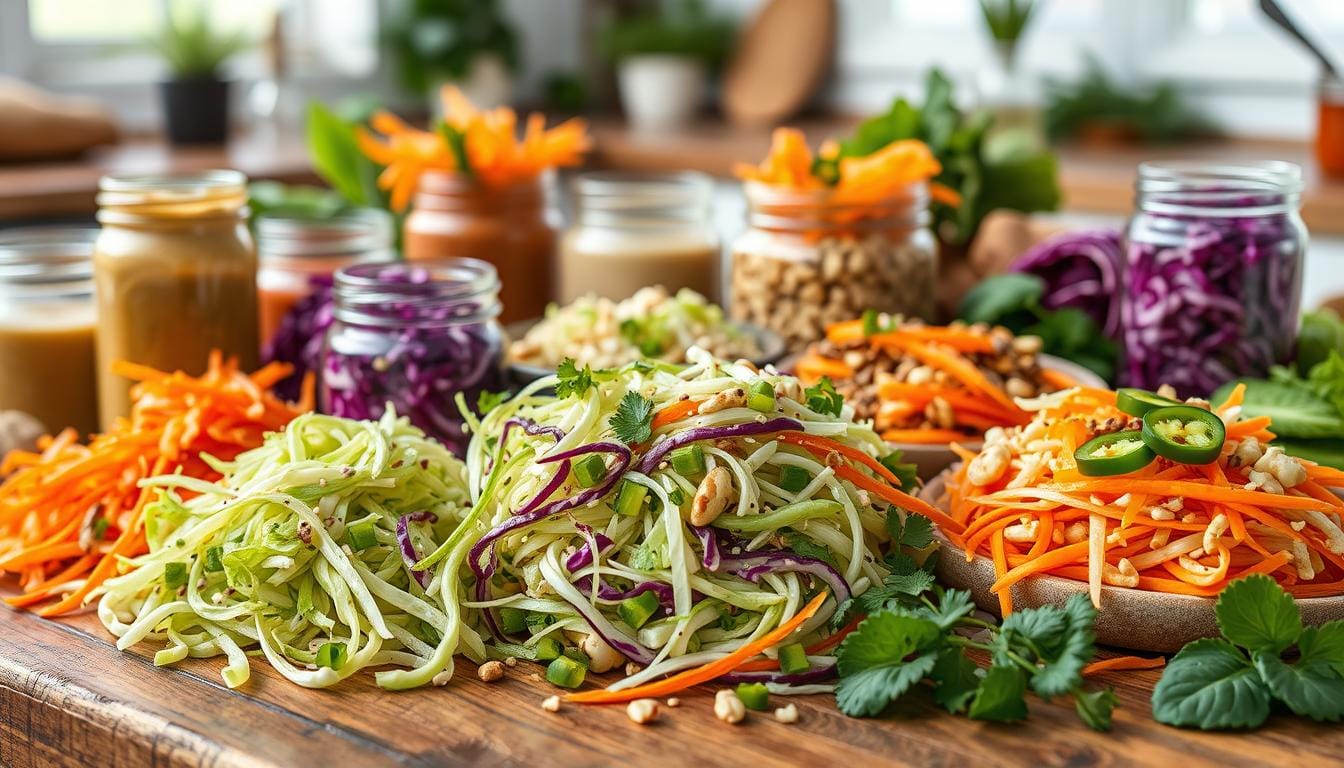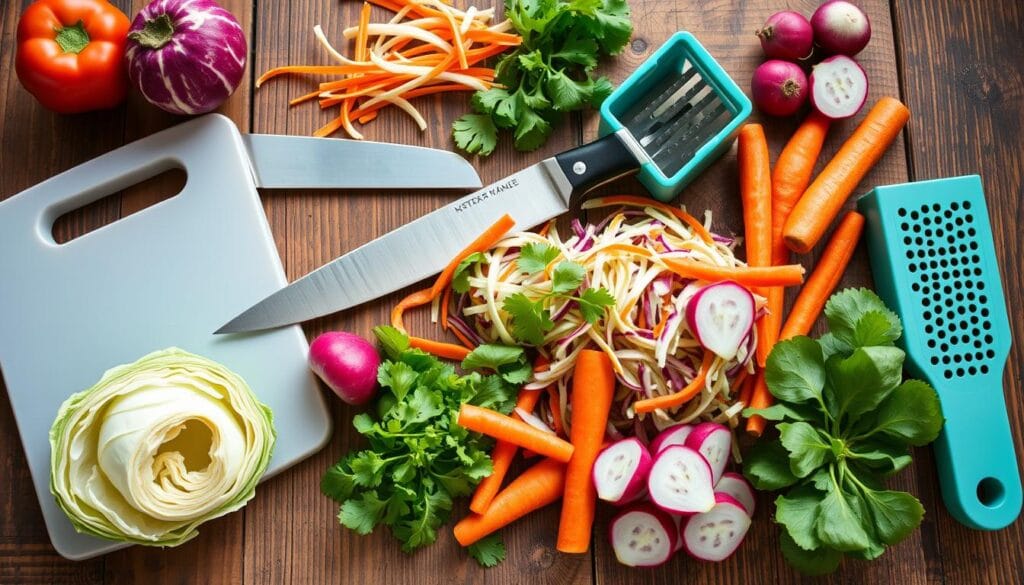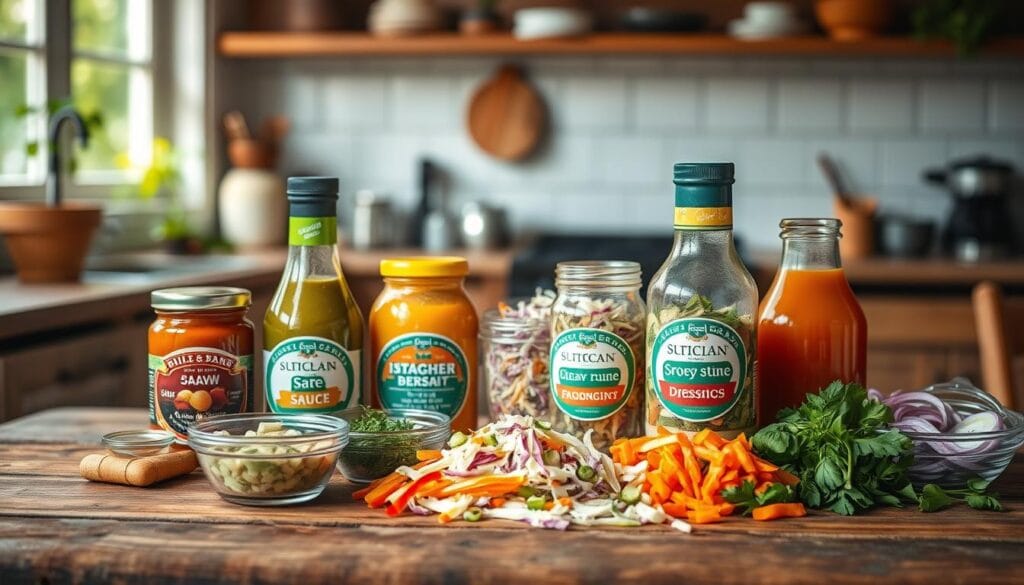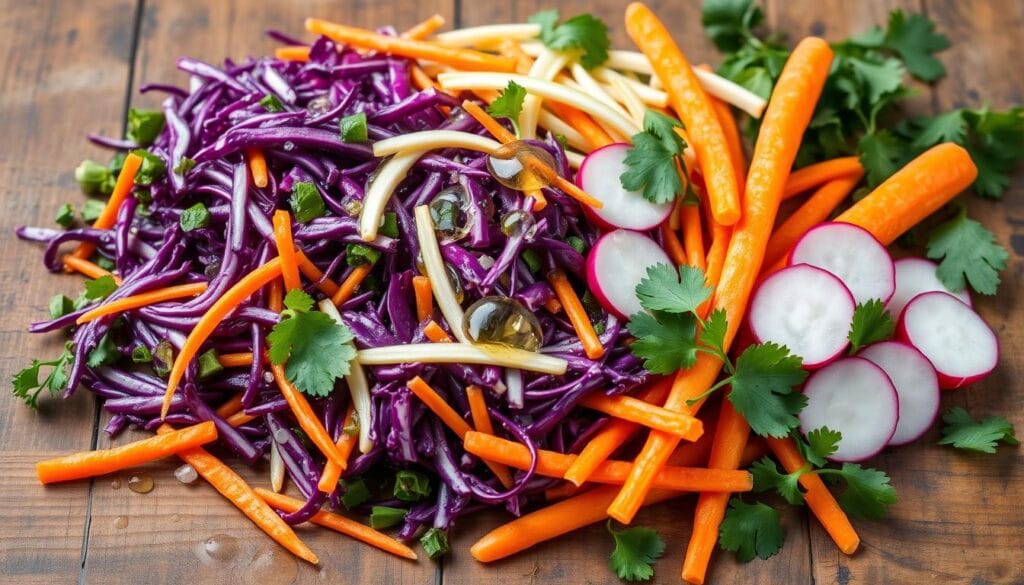I love making slaws and have spent hours perfecting them. I want to share my tips to make your slaws look and taste amazing. Whether it’s a classic coleslaw or something new, the secret is in the details and creativity. Let’s explore how to make your slaws stand out.
Slaw can turn a simple dish into something special. It’s all about the crunch and flavor. In this guide, we’ll cover the basics, tools, and techniques. Plus, we’ll explore flavor combinations that will excite your taste buds.
Understanding the Basics of Slaws Preparation
Coleslaw, or slaw, is a classic side dish that adds a refreshing crunch and vibrant flavor to various meals. It’s perfect with burgers, grilled chicken, or pulled beef. Knowing how to make slaw can help you create the perfect side dish. Let’s explore the key elements that make slaw stand out.
What is Slaws?
Slaw is a salad made mainly from shredded or finely chopped cabbage. The term “slaw” comes from the Dutch word “slaa,” meaning “salad.” While cabbage is the base, slaw can also include other crunchy veggies like carrots and broccoli. This mix of flavors and textures makes slaw special.
Key Ingredients for Delicious Slaws
- Cabbage: The star ingredient, cabbage gives the slaw its signature crunch and texture. You can use green, red, or Savoy cabbage.
- Carrots: Shredded or julienned carrots add color and a subtle sweetness to the slaw.
- Dressing: The dressing, often creamy or vinegar-based, holds the slaw together and adds flavor.
- Herbs and Seasonings: Fresh herbs like parsley or dill, and spices like celery seed or poppy seed, enhance the slaw’s taste.
Types of Cabbage and Vegetables to Consider
While green cabbage is traditional, trying different cabbage varieties can add depth and beauty to your slaw. Red cabbage, with its vibrant color and peppery flavor, is a stunning choice. Savoy cabbage, with its delicate leaves, also makes a great slaw base. Adding shredded carrots, broccoli, or thinly sliced Brussels sprouts can make your slaw more diverse and nutritious.
| Cabbage Variety | Flavor Profile | Texture |
|---|---|---|
| Green Cabbage | Mild, slightly sweet | Crisp, dense |
| Red Cabbage | Slightly peppery, bolder | Crisp, crunchy |
| Savoy Cabbage | Delicate, sweet | Tender, lacy |
By understanding slaw basics, you’ll be ready to make colorful, flavorful, and delicious slaws. These slaws will enhance a wide range of dishes.
Essential Tools for Making Slaws
Making delicious slaws is easy with the right kitchen gadgets. From chopping veggies to mixing dressing, the right tools make a big difference. Let’s look at the must-have tools and gadgets for making amazing slaws.
Must-Have Kitchen Tools
Great slaws start with good prep. Get a sharp chef’s knife, a strong cutting board, and a reliable grater or mandoline. These tools help you slice and shred veggies perfectly.
Choosing the Right Knife
A top-notch chef’s knife is key for slicing and dicing. Choose a blade that’s at least 8 inches long. It should be sharp and durable, cutting through veggies easily. A well-balanced knife with a comfy grip makes chopping simple.
Food Processor Versus Manual Prep
- A food processor with a shredding disc is a big help for quick, even shredding. Its sharp blades turn cabbage and other veggies into perfect strips fast.
- If you like doing things by hand, a sharp knife and a sturdy mandoline slicer work great. They let you control the texture and make uniform slaw.
Choose the tools that fit your slaw-making style. Try different methods to find your favorite way to make slaw.
Prep Time and Techniques: Slaws
Starting a slaw project means learning to chop veggies well. Whether it’s a classic coleslaw or something new, cutting veggies evenly is crucial. It makes the slaw both tasty and pretty.
How to Properly Chop Vegetables
First, pick a sharp knife for the job. A chef’s knife or Santoku knife is best for slaw. Slice the veggies carefully, keeping your fingers curled to avoid cuts. Aim for thin, even strips for the best taste and texture.
The Importance of Uniform Sizes
It’s important to have veggies of the same size for a smooth slaw. If they’re not, cooking times will vary, and it won’t taste right. Spend time chopping or shredding to get a mix that’s pleasing to the eye and taste buds.
Time-Saving Tips for Efficient Prep
- Use a food processor or mandoline slicer to shred veggies fast, saving time.
- Prepare your ingredients ahead and store them in the fridge until you’re ready to make your slaw.
- Buying pre-shredded coleslaw mixes can be easy, but remember, they might not taste or feel the same.
By learning to chop veggies well and using these tips, you’ll make slaws that are both delicious and beautiful. Your family and friends will love them.
Creative Dressing Ideas: Slaws
Adding the right dressing can turn a simple slaw into a masterpiece. You can choose from classic vinaigrettes to creamy dressings. Each option brings its own flavor to your slaw.
Classic Vinaigrettes to Try: Slaws
Vinaigrettes are a timeless choice for slaw dressings. Try different vinegars like apple cider, lemon, or balsamic. Mix them with oil, acid, and spices for a tangy taste.
Creamy Dressings: When to Use Them
For a richer slaw, creamy dressings are perfect. Use mayonnaise, yogurt, or sour cream. They add a luxurious feel and a creamy taste that’s great with bold slaws.
Flavor Enhancements: Herbs and Spices
- Add fresh herbs like parsley, cilantro, or dill for a fresh flavor.
- Spices like cumin, paprika, or chili powder add depth to your dressing.
- Citrus zest and juice brighten your dressing and enhance the slaw’s sweetness.
Slaw dressing recipes and vinaigrettes are key to a great slaw. By trying these dressing ideas, you can make your slaw truly special.
Adding Crunch and Color: Slaws
Make your slaw stand out by adding colorful slaw ingredients and crunchy slaw additions. Don’t just stick to cabbage. Try fresh, vibrant veggies for texture and color.
Unique Vegetables for Vibrant Slaw
Move past green and red cabbage. Add shredded carrots, sliced radishes, and julienned bell peppers. Thinly sliced celery, grated zucchini, or broccoli stems also work well. These colorful slaw ingredients make your slaw both beautiful and tasty.
Nuts and Seeds: Texture Boosters
Get a crunchy texture from nuts and seeds. Chopped almonds, toasted pecans, or pumpkin seeds are great. Sprinkle them on top or mix them in for a nice contrast.
Using Seasonal Produce for Freshness
Use seasonal produce for a fresh slaw. In summer, add watermelon radish or shredded fennel. In fall and winter, try Brussels sprouts, apples, or roasted butternut squash. Seasonal colorful slaw ingredients keep your slaw vibrant.
By mixing colorful slaw ingredients and crunchy slaw additions, you get a stunning slaw. Try new veggies and seasonal produce for a unique slaw every time.
Flavor Profiles to Explore: Slaws
Slaw offers endless flavor options. You can find everything from sweet and tangy to savory and spicy. Regional coleslaw recipes mix sweet, sour, and savory tastes. Think of Carolina-style slaw with mustard or Hawaiian slaw with pineapple and ginger.
Sweet, Sour, and Savory Combinations
For a flavorful slaw, mix sweet, sour, and savory. Use crisp cabbage and carrots as a base. Add a dressing with tangy vinegar, creamy mayonnaise, and a bit of honey or maple syrup.
Try adding Dijon mustard, Worcestershire sauce, or parmesan cheese for extra flavor.
Regional Variations of Slaws Recipes
- Southern-style slaw flavor combinations often have a creamy dressing. They use buttermilk or a bit of sugar.
- In the Midwest, slaws have vinegar-based dressings. They add shredded apples or carrots for sweetness.
- On the West Coast, regional coleslaw recipes mix Asian flavors. They use sesame oil, rice vinegar, and toasted sesame seeds.
Pairing with Meats and Other Dishes
Slaw is great with many foods. It pairs well with pulled beef or barbecue. For a lighter choice, try a zippy lemon-dill slaw with grilled fish or chicken.
“Slaw is the unsung hero of the culinary world. Its crisp texture and bright flavors can elevate any meal, from burgers to tacos and beyond.”
Customizing Your Slaws Recipe
Creating the perfect slaw means making it your own. You can follow vegan slaw recipes or choose a gluten-free coleslaw. There are many ways to customize your dish.
Dietary Considerations: Vegan and Gluten-Free
Slaw can be adapted for dietary needs. Use plant-based alternatives like cashew cream or vegan yogurt instead of mayonnaise. Choose dairy-free ingredients and make sure your vinegar and seasonings are gluten-free.
Portion Control: Making it Personal
Slaw can be made to fit your appetite. Adjust the size based on how many you’re serving. Use small slaws as toppings or make larger servings as a main dish.
Experimenting with Textures and Flavors
Get creative with textures and flavors. Add crunchy veggies like kohlrabi, jicama, or radishes. Try fresh herbs, spices, or citrus zest in your dressing. Explore different styles, like tangy Amish slaw or creamy Mexican-style slaw.
| Ingredient | Benefits |
|---|---|
| Kohlrabi | Adds a crisp, juicy texture and a slightly peppery flavor. |
| Jicama | Provides a satisfying crunch and a mild, sweet taste. |
| Radishes | Offer a peppery, crunchy contrast to the creamy dressing. |
“The key to a delicious slaw is finding the right balance of flavors and textures. Don’t be afraid to experiment and discover your own signature slaw recipe.”
Think about your dietary needs and portion sizes when making slaw. Try different ingredients to create a slaw that shows off your taste. Let your creativity shine with this versatile dish.
Presentation Tips for Beautiful Slaws
Making your slaw look good is as key as getting the taste right. Focus on colors, serving ideas, and garnishes to make your slaw stand out. Here are some tips to make your slaw presentation pop.
Color Coordination for Appeal
The colors of slaw ingredients, like red cabbage and green carrots, are perfect for artful plating. Arrange them in a way that looks good and matches well. Use a clear bowl or plate to show off the colors and textures.
Serving Suggestions for Gatherings
For big gatherings, serve slaw in small portions. It looks fancy and makes it easy for guests to grab their own. Try using small bowls, cups, or even bell pepper rings as unique serving dishes.
Garnishing for Extra Flair
- Add toasted nuts, seeds, or crispy shallots for crunch and texture.
- Use fresh herbs like cilantro or chives for color and smell.
- Drizzle a contrasting dressing in a pretty pattern.
- Top with radishes, apple matchsticks, or purple cabbage for a striking look.
By focusing on color, serving style, and garnishes, you can turn simple slaw into a showstopper. With a bit of care, your slaw will delight both the eyes and taste buds.
| Metric | Value |
|---|---|
| Prep Time | 10 minutes |
| Total Time | 10 minutes |
| Servings | 6 |
| Calories per serving | 218 |
| Recipe Rating | 4.80 out of 5 from 59 votes |
| Slaw Storage | Up to 3 days in the fridge |
| Freshness Recommendation | Consume within 2 days |
“Elevating the visual appeal of your slaw is just as important as nailing the flavors. By paying attention to color coordination, serving suggestions, and creative garnishing, you can transform a simple coleslaw into a visually stunning dish that will impress your guests.”
Storage and Freshness Tips
Keeping your slaw fresh is all about how you store it. Here are some tips to keep your coleslaw tasting great:
- Put slaw in an airtight container in the fridge. This keeps it moist and prevents it from getting soggy.
- Eat your slaw within 3-4 days for the best taste. The flavors will get better over time.
- Don’t freeze slaw. It will get watery and soggy when thawed because of its high water content.
Reviving Wilting Slaws
If your slaw starts to wilt, don’t worry. You can make it fresh again:
- Just rinse it under cold water and dry it with paper towels.
- Add a bit of dressing and toss it gently to coat the slaw.
- For extra crunch, mix in some fresh, shredded cabbage or carrots.
| Slaw Storage Methods | Coleslaw Shelf Life |
|---|---|
| Airtight container in the fridge | 3-4 days |
| Avoid freezing | Not recommended |
By using these slaw storage methods and knowing about coleslaw shelf life, you can enjoy fresh slaw for days. A little care can keep your homemade or store-bought slaw fresh and tasty.
Troubleshooting Common Slaws Issues
As a seasoned slaw enthusiast, you may face a few common challenges. Don’t worry, we have the solutions to help you overcome these obstacles. This way, you can serve up consistently delicious coleslaw.
Overly Watery Slaws Solutions
If your slaw is too watery, the problem is often the cabbage. To fix this, try salting the shredded cabbage and letting it sit for 30 minutes. Then, rinse and pat it dry. This helps remove excess moisture, making the slaw crisper and more flavorful.
Also, adding a small amount of cornstarch or flour to the dressing can thicken it. This prevents it from becoming too runny.
Enhancing Flavor Without Adding Calories
Want a healthier slaw without losing flavor? Try using aromatic herbs like dill, cilantro, or chives. They add freshness without needing heavy dressings. A splash of apple cider vinegar or lemon juice can also brighten the taste.
Remember, a little goes a long way in enhancing your slaw’s flavors.
Fixing Awkward Textures in Your Slaws
If your slaw has an unpleasant texture, adjust how you prepare the vegetables. Make sure all the cabbage and other ingredients are sliced or shredded to the same thickness. For a smoother texture, pulse the vegetables in a food processor instead of chopping them by hand.
If the slaw is too soft, add something crunchy like toasted nuts, seeds, or shredded carrots. This will help restore the right texture.
FAQ
What is slaw?
Slaw is a salad made from shredded cabbage and other veggies. It’s a versatile dish with many preparation options.
What are the key ingredients for delicious slaw?
Delicious slaw needs shredded cabbage, carrots, onions, and a tasty dressing. The dressing can be made with vinegar, mayonnaise, or yogurt.
What types of cabbage and vegetables can I use in slaw?
You can use green, red, or Napa cabbage in slaw. Other veggies like broccoli, Brussels sprouts, and fruits like apples or pineapple also work well.
What kitchen tools are essential for making slaw?
Essential tools for slaw include a sharp knife, mandoline slicer, food processor, and a large bowl.
How do I properly chop the vegetables for slaw?
Use a sharp knife to chop veggies for slaw. Make sure the pieces are uniform for even cooking and texture.
What are some classic vinaigrette recipes to try for slaw?
Try a simple white vinegar and oil dressing, a tangy Dijon mustard vinaigrette, or a sweet apple cider vinegar dressing for slaw.
When should I use a creamy dressing for my slaw?
Use creamy dressings like mayonnaise or yogurt for a richer slaw. They’re great with pulled beef or fried chicken.
What are some unique vegetables I can add to my slaw for extra crunch and color?
Add radishes, jicama, bell peppers, or shredded beets to your slaw. They add crunch and color.
How can I create different flavor profiles for my slaw?
Mix sweet, sour, and savory ingredients for different flavors. Try Asian or Mexican-style slaws or pair with other dishes.
How can I customize my slaw recipe to accommodate dietary restrictions?
Make your slaw vegan or gluten-free by using plant-based dressings. Avoid dairy and wheat. Adjust portion sizes as needed.
How can I present my slaw in an appealing way?
Use color coordination and serve in a beautiful bowl or on a platter. Garnish with fresh herbs, nuts, or other elements.
How long does slaw last in the fridge, and how can I revive wilting slaw?
Slaw lasts 3-5 days in the fridge. Revive wilting slaw by adding fresh dressing and gently tossing.
How can I fix a watery slaw or enhance the flavor without adding more calories?
Drain excess liquid from watery slaw. Add more crunchy veggies or a thicker dressing. Use fresh herbs, spices, or citrus juice for flavor without extra calories.





